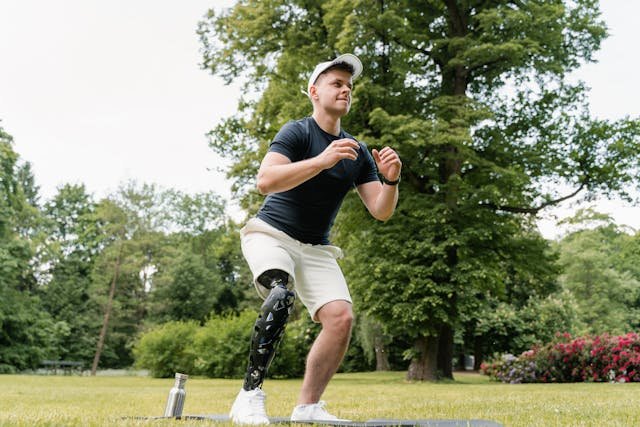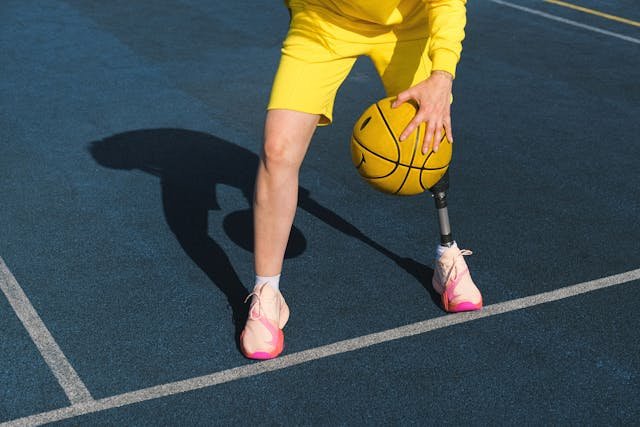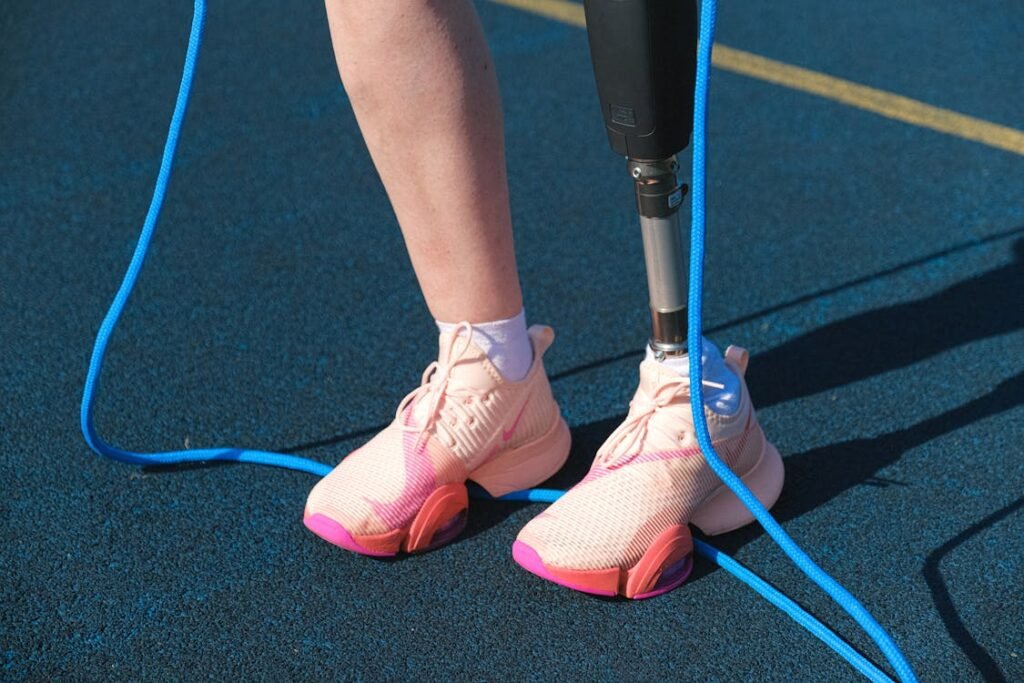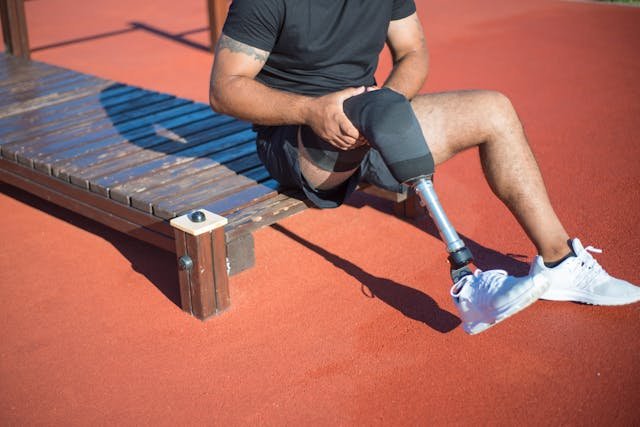For amputees who love sports, finding the right prosthetic knee can make all the difference. Whether it’s basketball, soccer, martial arts, or track and field, agility-based sports require quick movements, explosive jumps, and strong landings. Standard prosthetic knees are designed for walking and daily activities, but high-performance knees are built to handle the demands of athletic movement.
A great prosthetic knee should provide stability, flexibility, and shock absorption to help athletes move freely and confidently. It should also be durable enough to withstand high-impact activities while offering smooth motion. The best knees for jumping and agility sports use advanced technology, including hydraulic systems, carbon fiber materials, and microprocessor controls to mimic natural movement.

Understanding the Needs of Athletes in Agility-Based Sports
Athletes who participate in sports that require jumping, sprinting, and rapid changes in direction need a prosthetic knee that can keep up with intense physical demands.
Unlike walking or jogging, agility-based sports involve high-impact movements, sudden stops, and quick turns. A prosthetic knee for these activities must be designed to handle stress while providing balance, control, and power.
The Importance of Stability and Shock Absorption
When an athlete lands from a jump or pivots suddenly, the knee joint absorbs significant force. If a prosthetic knee lacks proper shock absorption, the impact can travel up the limb, causing discomfort or even injury.
High-performance prosthetic knees use advanced materials like carbon fiber and hydraulic damping systems to absorb shock efficiently. This reduces strain on the residual limb and allows for smoother movement.
Stability is also a key factor. In sports like basketball and volleyball, where athletes jump frequently, the knee must provide support upon landing.
A high-quality knee joint should remain steady, preventing unwanted movement that could lead to falls. Some modern prosthetic knees include microprocessors that adjust in real-time, offering greater control and stability for athletes during high-speed movements.
Energy Return for Explosive Movements
One of the biggest challenges for amputees in sports is generating enough power for explosive movements. Whether it’s jumping for a rebound in basketball or sprinting in soccer, the ability to push off the ground with force is crucial.
Prosthetic knees designed for agility sports incorporate energy-return technology, which stores energy upon impact and releases it when the user moves forward.
Energy return is especially important for jump-intensive sports. A well-designed prosthetic knee, paired with a suitable foot component, can help athletes regain the spring-like effect of natural muscles and tendons.
The result is higher jumps, quicker acceleration, and smoother landings.
Adaptability to Fast Direction Changes
Many agility-based sports require rapid lateral movements and sudden changes in direction. A prosthetic knee must respond quickly and provide smooth transitions without stiffness or delay.
Traditional mechanical knees may not be able to keep up with these rapid adjustments, which is why athletes benefit from advanced models with built-in sensors and adaptive technology.
Microprocessor-controlled knees are particularly effective for sports that involve unpredictable movements. These knees use sensors to detect changes in movement and adjust resistance accordingly.
This means that whether an athlete is making a sharp turn, stopping suddenly, or shifting weight between legs, the prosthetic knee responds instantly to maintain balance and fluidity.
Durability and Long-Term Performance
Agility sports put extreme stress on a prosthetic knee. Constant impact, twisting motions, and high-speed movements require a knee joint that is not only high-performing but also durable.
Prosthetic knees made from aerospace-grade materials such as titanium and carbon fiber offer both strength and lightweight performance.
Additionally, proper maintenance is crucial to ensuring long-term reliability. Athletes should work with their prosthetists to keep their knee joints in top condition, making necessary adjustments based on wear and tear.
Choosing a knee designed for sports performance can make a huge difference in longevity and reduce the risk of mechanical failure during competition.

Top Prosthetic Knee Technologies for Jumping and Agility Sports
Prosthetic knees have come a long way in recent years, with advanced designs that help athletes push their limits.
Whether you are performing high jumps, sprinting, or making quick directional changes, the right prosthetic knee should mimic natural movement while providing extra stability and power.
The best prosthetic knees for agility sports incorporate cutting-edge technologies that enhance performance and comfort.
Microprocessor-Controlled Knees for Real-Time Adaptation
One of the most significant advancements in prosthetic knee technology is the microprocessor-controlled knee (MPK). These knees use sensors to detect motion and adjust resistance instantly, providing smoother movement and better balance.
For athletes in agility-based sports, MPKs offer a major advantage. They allow for controlled landings, quick response to changes in direction, and natural-feeling movement while sprinting.
The sensors continuously monitor the user’s gait and make real-time adjustments, ensuring that each step is stable and energy-efficient.
Some of the most popular MPKs for sports include models equipped with hydraulic dampening, which absorbs impact and reduces stress on the limb.
These knees are especially useful for high-impact activities like long jumping or running, as they provide both control and shock absorption.
Hydraulic and Pneumatic Knees for Smooth Motion
Hydraulic and pneumatic knees use fluid or air pressure to regulate motion. This technology helps create a natural knee movement, reducing the stiffness that some mechanical knees have.
Hydraulic knees are particularly beneficial for sports that require explosive power. When an athlete jumps, the hydraulic system absorbs impact on landing and returns energy to assist with the next movement.
This makes jumping feel more natural and reduces strain on the residual limb.
Pneumatic knees, which use air pressure instead of fluid, are lighter and often preferred by athletes who need agility and speed. These knees provide smooth, controlled movements while allowing for quick changes in pace and direction.
Energy-Storing Knees for Maximum Jump Power
A critical factor in agility-based sports is the ability to generate explosive movements. Some prosthetic knees are designed with energy-storing capabilities, allowing them to absorb impact and release energy when the athlete pushes off.
These knees work by mimicking the natural spring-like effect of muscles and tendons. When the user lands from a jump, the knee stores kinetic energy and releases it to help propel the next movement.
This technology is especially valuable for track and field athletes, basketball players, and martial artists who rely on bursts of power for their performance.
Paired with an energy-return prosthetic foot, these knees help amputees maximize their jumping height, sprinting ability, and agility. The result is a smoother, more powerful movement that feels natural and efficient.
Multi-Axis Knees for Advanced Mobility
Traditional prosthetic knees often operate on a single axis, meaning they bend in only one direction. However, agility sports require multi-directional movement, making multi-axis knees a better option for active individuals.
Multi-axis knees allow for natural rotation, which is essential for sports that involve pivoting, turning, and rapid side-to-side motion.
Athletes who participate in soccer, tennis, or martial arts benefit from this added mobility, as it provides greater freedom of movement and reduces strain on the residual limb.
These knees are often combined with microprocessor control or hydraulic dampening to offer the best combination of flexibility, stability, and responsiveness.
By adapting to different angles of movement, multi-axis knees make high-speed changes in direction smoother and more controlled.
Customization and Fine-Tuning for Sports Performance
Every athlete has unique needs, and prosthetic knees for sports should be customized to fit the user’s specific activity level and preferences.
Many advanced knee models come with adjustable settings that allow users to fine-tune resistance, flexibility, and energy return based on their sport.
Athletes working with a prosthetist can optimize their knee’s performance by adjusting the damping level for better shock absorption, increasing or decreasing resistance for smoother movement, and ensuring that the knee responds naturally to their gait.
Customization ensures that the prosthetic knee functions at its best, helping athletes feel more confident and in control during high-intensity movements.

Choosing the Right Prosthetic Knee for Your Sport
Selecting the best prosthetic knee for agility-based sports depends on several factors, including the type of sport, activity level, and personal comfort.
Not all prosthetic knees are designed for high-impact movements, so understanding your specific needs will help you find the best option.
Matching the Prosthetic Knee to Your Sport
Different sports require different types of movement, and the ideal prosthetic knee will depend on how the sport is played.
For basketball and volleyball, where jumping is frequent, a prosthetic knee with energy return and shock absorption is essential.
Knees with hydraulic or pneumatic technology help athletes land safely and prepare for the next movement without excessive impact on the residual limb.
For soccer and tennis, where quick lateral movements and direction changes are necessary, a multi-axis knee with microprocessor control can provide the stability and flexibility needed to move naturally.
These knees allow for fast pivots and weight shifts, reducing the risk of falls or strain.
For track and field, sprinting, and long jumping, an energy-storing knee that enhances push-off power is the best option. These knees store kinetic energy with each step and release it during acceleration, allowing for greater speed and efficiency.
For martial arts and gymnastics, where balance and controlled movement are crucial, a knee with precise stability control is recommended. Microprocessor knees with real-time adjustments help maintain balance and support the body’s weight through dynamic movements.
The Role of Suspension Systems in Sports Performance
The suspension system of a prosthetic leg plays a crucial role in sports performance. A well-fitted socket and secure suspension system ensure that the prosthetic knee stays firmly in place, reducing unwanted movement or instability.
Vacuum suspension systems offer a snug fit, preventing the limb from shifting during fast movements. This helps improve confidence and reduces friction, which can cause discomfort.
Athletes who perform high-impact activities often prefer this type of suspension because it provides excellent control over their prosthetic limb.
Comfort and Fit for Maximum Performance
Even the most advanced prosthetic knee will not perform well if it does not fit comfortably. Athletes should work closely with their prosthetist to ensure that the knee joint aligns correctly with the residual limb.
A well-fitted knee prevents pressure points, reduces strain, and allows for a more natural movement pattern.
Proper alignment also ensures that weight is distributed evenly, reducing fatigue and improving endurance. Athletes should have their prosthetic knee adjusted regularly to accommodate any changes in muscle strength, limb shape, or activity level.
Testing and Adapting to a New Prosthetic Knee
Transitioning to a high-performance prosthetic knee takes time and practice. Athletes should start with basic movements before gradually increasing intensity. Working with a physical therapist or prosthetist can help fine-tune movements and ensure proper form.
It is important to test the knee in different sports environments, whether on the court, track, or field, to make necessary adjustments.
Some prosthetic knees come with customizable settings that allow athletes to adjust resistance and response levels based on their sport’s specific needs.
Building confidence with a new prosthetic knee is a gradual process, but with consistent practice and the right technology, athletes can regain agility, speed, and jumping ability.

Training and Rehabilitation for Athletes Using Prosthetic Knees
Getting the most out of a high-performance prosthetic knee requires more than just the right technology—it also involves proper training and rehabilitation.
Athletes need to strengthen their muscles, improve coordination, and develop confidence in their movements. By incorporating targeted exercises and rehabilitation techniques, amputees can enhance their agility, jumping ability, and overall athletic performance.
Strength Training for Stability and Power
Athletes using prosthetic knees must develop strength in key muscle groups to improve balance and mobility. Core strength is especially important, as it helps stabilize the body during rapid movements and impacts.
Exercises such as planks, sit-ups, and rotational core workouts can strengthen the abdominal and lower back muscles, reducing the risk of imbalance when jumping or sprinting.
For leg amputees, strengthening the hip and glute muscles is essential. These muscles provide power during explosive movements, such as jumping and sprinting.
Squats, lunges, and resistance band exercises help build stability and ensure that the prosthetic knee moves in sync with the body.
Upper-body strength is also important for athletes who rely on arm motion to generate power, such as in basketball or sprinting. Push-ups, pull-ups, and resistance exercises can help improve overall coordination and balance.
Balance and Coordination Drills
Prosthetic knees for agility-based sports require precise coordination to function effectively. Balance exercises help athletes develop better control over their movements and adapt to changes in direction.
Single-leg balancing exercises, such as standing on one foot while engaging the core, help improve stability. Athletes can progress by adding dynamic movements, such as reaching forward or sideways while balancing.
Agility ladder drills and cone drills improve footwork, reaction time, and coordination. These drills mimic the fast-paced movements of sports and help athletes become more confident in their prosthetic knee’s response to sudden direction changes.
Plyometric Training for Explosive Jumping
Jumping requires both strength and technique, and plyometric training helps amputees develop the explosive power needed for sports like basketball, volleyball, and track and field. Plyometrics focus on quick, controlled movements that improve the ability to generate force.
Box jumps, step-ups, and depth jumps can help athletes learn how to use their prosthetic knee effectively for jumping. Starting with low-impact variations and gradually increasing intensity allows for safe adaptation to high-impact activities.
Practicing controlled landings is just as important as jumping itself. Proper landing mechanics, such as bending the knee upon impact and distributing weight evenly, reduce stress on the prosthetic limb and lower the risk of injury.
Sport-Specific Drills and Adaptation
Athletes should incorporate sport-specific drills into their training routine to ensure their prosthetic knee performs optimally in real-game scenarios.
For example, a soccer player may practice dribbling and quick pivots, while a basketball player focuses on shooting and defensive footwork.
Working with coaches, trainers, or rehabilitation specialists who understand the mechanics of prosthetic movement can help refine technique and make necessary adjustments.
Customized training programs ensure that athletes maximize their potential while preventing overuse injuries.
Mental Conditioning and Confidence Building
Physical training is only part of the equation—mental conditioning is just as important for athletes using prosthetic knees. The transition to a high-performance prosthetic can be challenging, and developing a strong mindset helps overcome self-doubt and performance anxiety.
Visualization techniques, such as mentally rehearsing movements before executing them, can improve confidence and coordination. Athletes can also benefit from mindfulness practices, such as deep breathing and meditation, to stay focused and calm under pressure.
Support from peers, coaches, and the adaptive sports community can be incredibly motivating. Connecting with other athletes who have similar experiences can provide inspiration and encouragement throughout the journey.
Training and rehabilitation are key to unlocking the full potential of a prosthetic knee. With the right combination of strength, balance, agility, and mental focus, amputee athletes can compete at a high level and perform with confidence.

Real-World Success: Athletes Thriving with Prosthetic Knees
Advancements in prosthetic knee technology have enabled athletes around the world to return to competitive sports and even reach new heights in their performance.
Whether in Paralympic competitions, professional leagues, or recreational sports, amputees are proving that agility, speed, and jumping power are all achievable with the right prosthetic knee and training.
Stories of Athletes Defying Limits
Many amputee athletes have embraced high-performance prosthetic knees to compete at elite levels. In track and field, sprinters and long jumpers rely on energy-storing knees to propel themselves forward with explosive speed.
Some of the fastest amputee sprinters in the world use prosthetics with advanced microprocessor control and carbon-fiber components to optimize every stride.
In basketball, players using prosthetic knees are executing powerful jumps, sharp pivots, and defensive footwork. These athletes demonstrate that agility and quick reaction times are possible with the right prosthetic adaptation.
With strong suspension systems and well-aligned knee joints, they maintain control during fast breaks, rebounds, and shooting motions.
Martial artists with prosthetic knees showcase remarkable flexibility, balance, and power in their movements. High-kicks, quick footwork, and defensive maneuvers require precise timing and coordination, which are enhanced by multi-axis knee technology.
These athletes prove that adaptive sports can be just as dynamic and skill-driven as traditional competition.
The Role of Adaptive Sports Organizations
The rise of adaptive sports programs has given amputee athletes more opportunities to compete and train at a high level.
Organizations such as the Paralympics, national adaptive sports leagues, and local amputee athletic programs provide the resources and coaching needed for athletes to refine their skills.
Many of these organizations collaborate with prosthetists and engineers to develop cutting-edge prosthetic technology. Continuous research and innovation ensure that athletes receive the best possible support, helping them push the limits of human performance.
Breaking Barriers and Inspiring the Next Generation
Athletes using prosthetic knees are breaking barriers in the sports world, proving that limb loss does not mean the end of an active lifestyle.
Their stories inspire young amputees to pursue their athletic dreams, showing that with the right prosthetic knee, training, and determination, anything is possible.
Beyond competition, these athletes advocate for greater accessibility in sports, pushing for better funding, equipment, and recognition for adaptive athletes.
Their success is not just personal—it paves the way for future generations of amputee athletes to have more opportunities to excel.
The Future of Sports Prosthetics
With continued advancements in prosthetic technology, the future for amputee athletes looks even brighter. Engineers are developing lighter, stronger, and smarter knee joints that mimic natural movement with even greater precision.
Artificial intelligence and biomechanics research are shaping the next generation of prosthetic knees, further closing the gap between human and robotic performance.
As prosthetic knees become more advanced, the possibilities for amputee athletes continue to expand. Whether it’s setting world records, competing at the highest levels, or simply enjoying the thrill of movement, the right prosthetic knee makes all the difference.

The Impact of Prosthetic Knee Design on Injury Prevention
For athletes, avoiding injuries is just as important as improving performance. When using a prosthetic knee in agility-based sports, the wrong fit or technology can increase the risk of strain, falls, and long-term complications.
A well-designed prosthetic knee not only enhances movement but also plays a crucial role in protecting the body from excessive impact and misalignment.
Reducing Impact Stress on the Residual Limb
Jumping and sprinting create significant impact forces that travel through the prosthetic limb and into the residual limb. Without proper shock absorption, these forces can cause discomfort, joint strain, and even long-term musculoskeletal damage.
Advanced prosthetic knees use hydraulic and pneumatic dampening systems to absorb shock, reducing the force that reaches the residual limb.
Energy-return technology also helps distribute impact more efficiently. When an athlete lands from a jump, an energy-storing knee temporarily holds kinetic energy and releases it to support the next movement.
This smooth transition prevents excessive force buildup, lowering the risk of stress-related injuries over time.
Preventing Overuse Injuries and Muscle Imbalances
One of the biggest concerns for amputee athletes is overuse injuries. When a prosthetic knee does not align properly with the body’s natural biomechanics, some muscle groups may overcompensate, leading to strain or fatigue.
For example, if a prosthetic knee lacks proper rotation control, an athlete may unknowingly put extra stress on the hip or lower back, increasing the risk of pain or injury.
Multi-axis prosthetic knees help reduce these risks by allowing movement in multiple directions, mimicking the way a natural knee would adapt to quick directional changes.
This prevents excessive torque on the residual limb and helps distribute movement more evenly across the body.
Stability Features That Reduce Fall Risks
In agility sports, sudden stops, pivots, and landings require precise balance. An unstable prosthetic knee can make these movements unpredictable, leading to slips or falls.
Microprocessor-controlled knees are especially effective at reducing these risks, as they adjust resistance in real time to match the user’s movements.
For athletes who engage in sports with frequent stops and turns, knee stability is critical. Knees with adaptive control mechanisms provide a smooth transition between different levels of resistance, allowing athletes to shift weight naturally without sudden jerks or instability.
This not only improves performance but also reduces the likelihood of falls and injuries.
Maintaining Joint Health for Long-Term Mobility
Using the wrong prosthetic knee can cause long-term wear and tear on the joints. If a knee joint does not match an athlete’s movement patterns, it may lead to misalignment, which can affect the hip, spine, and even the sound limb.
Proper knee selection ensures that weight is distributed evenly, reducing unnecessary stress on surrounding joints.
Regular adjustments and fine-tuning of the prosthetic knee help maintain joint health. Athletes should work closely with prosthetists to make sure their knee aligns correctly with their gait and activity level.
A well-maintained prosthetic knee will continue to provide the best combination of performance and protection, ensuring long-term athletic success.
Conclusion
Choosing the right prosthetic knee for agility-based sports is about more than just performance—it’s about confidence, safety, and long-term mobility. Athletes need a knee that provides stability, shock absorption, and energy return to support explosive movements like jumping and sprinting. With advancements in microprocessor control, hydraulic dampening, and multi-axis designs, today’s prosthetic knees allow amputees to compete at high levels while reducing injury risks.
Beyond technology, training and rehabilitation play a vital role in maximizing performance. Strength training, balance drills, and sport-specific conditioning help athletes adapt to their prosthetic knee and move with greater control. As more amputees excel in sports, the future of adaptive athletics continues to evolve, proving that limb loss is not a barrier to agility, speed, or power.
At Robobionics, we believe in pushing the boundaries of what prosthetics can achieve. If you’re looking for a high-performance prosthetic solution that keeps up with your active lifestyle, explore our innovations and book a consultation today. The right prosthetic knee can redefine what’s possible—helping you move with strength, agility, and confidence.



